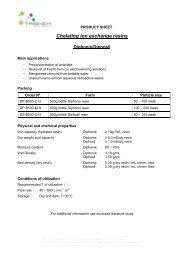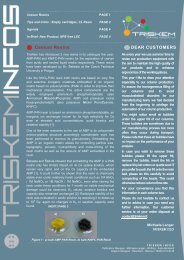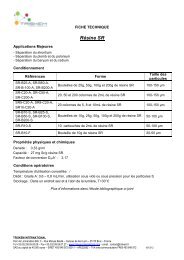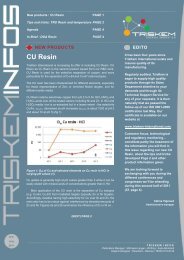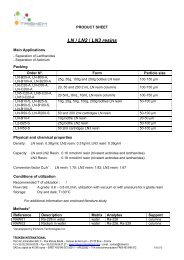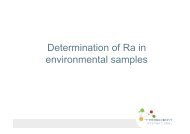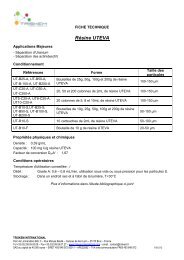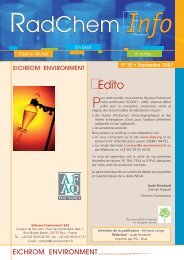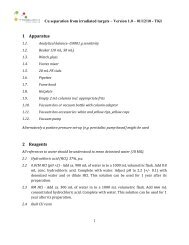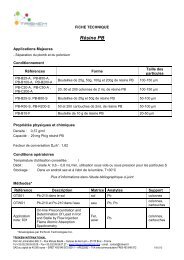RE Resin - TrisKem International
RE Resin - TrisKem International
RE Resin - TrisKem International
Create successful ePaper yourself
Turn your PDF publications into a flip-book with our unique Google optimized e-Paper software.
N°2<br />
December<br />
2008<br />
<strong>RE</strong> <strong>Resin</strong> PAGE 2<br />
Quality control of the resins PAGE 2<br />
Agenda PAGE 4<br />
In Brief PAGE 4<br />
RADIOCHEMISTRY EDITORIAL<br />
<strong>RE</strong> <strong>Resin</strong><br />
The <strong>RE</strong> (Rare Earth) resin is mainly used for the separation and<br />
determination of Rare Earth Elements (<strong>RE</strong>E), especially of the heavy<br />
<strong>RE</strong>Es. It is thus complementary to the LN resin which finds use in the<br />
separation of the light <strong>RE</strong>Es and radium (see also TKI N°1).<br />
The <strong>RE</strong> resin, like the TRU resin, is composed of CMPO<br />
(octyl(phenyl)-N,N-diisobutylcarbamoyl-methylphosphine oxide)<br />
dissolved in TBP (tributyl phosphate) and impregnated onto an inert<br />
support. In case of the <strong>RE</strong> resin the proportion of CMPO used is higher<br />
than for the TRU resin, with the aim of increasing its affinity for the<br />
<strong>RE</strong>Es.<br />
Huff and Huff (1) performed an extensive study on the retention of<br />
selected lanthanides and some other elements frequently found in<br />
samples from nitric and hydrochloric acid on <strong>RE</strong> and TRU resin (fig. 1<br />
– 3). Figures 3a) and 3b) compare the affinity of some elements to<br />
both resins in HNO3 and HCl. Iron is showing increasing retention with<br />
increasing acid concentration. In general the retention is stronger from<br />
nitric acid than from hydrochloric acid, only exceptions are<br />
molybdenum and tin. The tables also show that all elements are more<br />
strongly or at least similarly well retained on the <strong>RE</strong> resin compared to<br />
the TRU resin.<br />
(NEXT) PAGE 2<br />
Please note that <strong>TrisKem</strong> will be closed from evening of<br />
23 December to the morning of 5 January.<br />
We are glad to have you among our customers and<br />
wish you a merry Christmas, a good start into the New<br />
Year and a happy and successful year 2009!<br />
As the year 2008 draws to a close<br />
we would like to take the<br />
opportunity to thank you for your<br />
loyalty and trust. Since our<br />
independence in 2007 we have<br />
implemented all means to<br />
provide you with quality<br />
products and to support your<br />
analytical problems. You have<br />
probably received our first<br />
customer satisfaction survey and<br />
we thank you in advance for<br />
being so kind as to participate to<br />
it. Thanks to your answers we<br />
will be able to improve our<br />
services and products.<br />
This 2008 last issue presents you<br />
the characteristics and<br />
properties of the <strong>RE</strong> resin. We<br />
are increasingly receiving<br />
requests concerning this resin,<br />
so it seemed logical to dedicate<br />
this last issue to its capacities.<br />
<strong>TrisKem</strong> <strong>International</strong> will be<br />
present in different conferences<br />
and workshops in 2009. You will<br />
find the details of these<br />
conferences page 4.<br />
Aude Bombard<br />
Product Manager<br />
TRISKEM INFOS<br />
Publication Manager : Michaela Langer • Writting : Aude Bombard<br />
Graphic Designer : Essentiel – Cesson-Sévigné • Printer : IPO-Bruz<br />
ISSN 1968-9225
Quality Control of the<br />
resins<br />
All our resins undergo at least<br />
one quality control. Bulk resin is<br />
tested in batch after each lot<br />
production. The qualified lot is<br />
used either for bottle or column<br />
packing. The resin packed in<br />
column is again qualified. Starting<br />
in January 2009, quality control<br />
on bulk resin assigned to bottle<br />
packaging will be done on column<br />
of bulk resin and no longer on<br />
batch mode. This will allow us to<br />
get a quality control closer to your<br />
uses and to get finer acceptance<br />
criteria.<br />
Figure 1 : Distribution coefficients Kd’ of lanthanides<br />
on TRU <strong>Resin</strong> (1).<br />
Figure 2 : Distribution coefficients Kd’ of lanthanides on<br />
TRU <strong>Resin</strong> (1).<br />
Esser et al. (2) have been<br />
using the <strong>RE</strong> resin for the<br />
separation and purification of<br />
lanthanides from natural water<br />
samples (well water, source<br />
water, sea water) before their<br />
measurement by ID-ICPMS.<br />
The lanthanides were<br />
concentrated using 2mL of a<br />
silicate impregnated with 8-<br />
Hydroxyquinoline before being<br />
purified using 100µL of <strong>RE</strong><br />
resin. In the first step<br />
(concentration) 1L of the water<br />
sample was used; the<br />
lanthanides were finally eluted<br />
from the <strong>RE</strong> resin using a<br />
volume of 1mL, resulting in an<br />
overall 1000-fold<br />
concentration.<br />
Beside for the <strong>RE</strong>Es the <strong>RE</strong><br />
resin also shows a strong<br />
affinity for yttrium. This fact<br />
lead Dietz and Horwitz to<br />
evaluating the use of the <strong>RE</strong><br />
resin for the production of Y-90<br />
for radiopharmaceutical<br />
purposes (3).The solution<br />
containing Sr-90 / Y-90 was<br />
passed several times through<br />
SR resin, the respective first<br />
fractions (load and rinse<br />
solutions) which contain the Y-<br />
90 were collected and unified.<br />
This unified solution was<br />
filtered, evaporated and<br />
redissolved in 2M HNO3<br />
before being passed over the<br />
<strong>RE</strong> resin. The yttrium is<br />
retained on the <strong>RE</strong> resin and<br />
can finally be eluted e.g. in a<br />
small volume of dilute<br />
hydrochloric acid.
Figures 3a and 3b : Distribution coefficients Kd’ of various elements in a) HNO3 and b) HCl media (1).<br />
Figure 4 : Elution curves of Fe, Y and Zr (3).<br />
Table 1 : Retention/elution of different elements on <strong>RE</strong><br />
resin. The eluted quantity of the element in each fraction is<br />
expressed in % of the originally introduced quantity (* -<br />
Fractions are expressed in FCV – Free Column Volume) (3).
AGENDA<br />
° ARABLAB - 10-13 January 2009,<br />
Dubai (United Arab Emirates)<br />
° European Winter Conference on<br />
Plasma Spectrochemistry - 15–20<br />
February 2009, Graz (Austria)<br />
° 14th Expert Level Meeting on<br />
Environmental Radioactivity<br />
Surveillance – 24-26 March 2009,<br />
Berlin (Germany)<br />
° 5th Local Radiochemical<br />
Conference – May 2009, Krakow<br />
(Poland)<br />
° Procorad - 24-26 June 2009,<br />
Grenoble (France)<br />
° Goldschmidt Conference – 21-26<br />
June 2009, Davos (Switzerland)<br />
° 17th <strong>International</strong> Conference on<br />
Radionuclide Metrology and its<br />
Applications (ICRM 2009) - 7–11<br />
September 2009, Bratislava<br />
(Slovakia)<br />
° The 12th Workshop on Progress in<br />
Analytical Methodologies for Trace<br />
Metal TRACESPEC 2009 – 15-18<br />
September 2009, Mainz (Germany)<br />
I N B RIEF<br />
Our first customer satisfaction<br />
survey has been sent by e-mail<br />
on 18 of November, and we<br />
thank all of you that have<br />
already answered. We are to resend<br />
it for those who could not<br />
answer the previous one. Your<br />
feedback is very important as it<br />
allows us to adjust and improve<br />
our services and products to<br />
your needs and expectations.<br />
Table 2 : Decontamination factors for different elements on <strong>RE</strong> resin (3).<br />
Bibliography<br />
The affinity of various elements for the <strong>RE</strong><br />
resin at 2M HNO3 is shown in table 1 and<br />
figure 4. One of the principal interferents of<br />
yttrium is iron. The recovery of Y in the<br />
iron-free fractions 10.8 – 81FCV is 69.3%.<br />
A higher iron decontamination could be<br />
obtained in increasing the number of<br />
fractions between 5.4 to 9FCV (by<br />
diminishing elution volume from 1.8 to<br />
1FCV for example).<br />
The decontamination factors obtained on<br />
<strong>RE</strong> resin are summarized in table 2. With<br />
respect to the high activities involved, the<br />
radiolysis stability of the resin was tested<br />
by determining the weight distribution ratios<br />
for Am of the resin after absorption of<br />
varying doses (table 3). It seems that the<br />
Am retention on <strong>RE</strong> resin is only very little<br />
effected by the absorbed doses, with Dw(0)<br />
= 287 and Dw(80) = 253. The authors<br />
could obtain, by combining SR and <strong>RE</strong><br />
resin, overall Sr-90 decontamination<br />
factors in the Y-90 fraction of nearly<br />
10E+09.<br />
Table 3 : Weight distribution ratios Dw of Am on <strong>RE</strong> resin. Conditions: approx.<br />
100mg of resin, Dw = Vaq(A0-As)/(m.As) – Vaq :volume of the aqueous phase,<br />
m :mass of resin, A0 and As : respective activities in the aqueous phase before<br />
and after extraction of the resin (3).<br />
(1) Huff E.A., Huff D.R., 34th ORNL/DOE Conference on Analytical Chemistry in<br />
Energy Technology, Gatlinburg-TN, USA (1993)<br />
(2) Esser B.K. et al., Anal. Chem., Vol.66, 1736 (1994)<br />
(3) Dietz M., Horwitz E.P., Applied Rad. Isot., Vol.43, 1093 (1992)<br />
DO NOT HESITATE TO CONTACT US FOR FURTHER DETAILS



